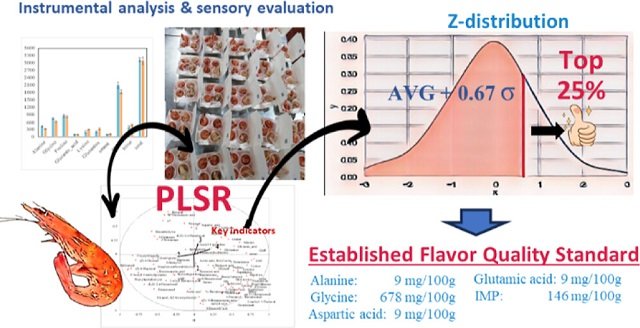
Traditionally, the size of white shrimp has been the primary determinant of its market value. However, this overlooks a crucial factor: flavor quality. While it is intuitive that superior flavor should command higher prices, accurately evaluating flavor quality has been a challenge.
To address this gap, scientists from the National Taiwan Ocean University embarked on an innovative study to develop a scientific framework for assessing the flavor quality of white shrimp (Litopenaeus vannamei). By meticulously analyzing sensory scores and instrumental data, the researchers uncovered intriguing correlations between specific amino acids and flavor perception.
The Challenge of Evaluating Flavor Quality
Traditionally, the market valuation of white shrimp focuses on size rather than flavor quality. However, superior flavor quality should theoretically command higher prices. The challenge lies in accurately assessing flavor quality, which is subjective and can vary among individuals. This study aimed to develop a scientific framework to overcome this challenge.
Decoding the Flavor Profile
The flavor of white shrimp is a complex interplay of aroma, taste, and sensory perception. While raw shrimp may not exhibit a strong aroma, cooking releases a bouquet of volatile compounds that contribute to its distinctive aroma. Key aroma-active compounds in cooked shrimp include 1-octen-3-ol, octanal, and hexanal.
Taste, on the other hand, is heavily influenced by the presence of free amino acids, nucleotides, and organic acids. These compounds work synergistically to create the sweet and umami flavor sensations characteristic of high-quality white shrimp. Notably, amino acids such as glycine, proline, arginine, taurine, glutamic acid, and alanine, along with nucleotides like inosine monophosphate (IMP) and guanosine monophosphate (GMP), significantly contribute to the overall flavor profile.
The Impact of Aquaculture Practices
The farming environment plays a crucial role in shaping the flavor of white shrimp. Salinity, in particular, influences the amino acid composition of shrimp. Shrimp cultivated in marine environments with higher salinity tend to have higher levels of glycine, proline, arginine, taurine, glutamic acid, and alanine, as well as higher levels of IMP and GMP, resulting in a more savory and desirable flavor profile.
The type of feed used in aquaculture also affects shrimp flavor. Diets based on fish oil, rich in omega-3 fatty acids, have been shown to enhance the flavor and texture of shrimp compared to soybean oil-based diets.
The Science Behind Flavor
The study, published in the journal ACS Food Science & Technology, revealed that higher sensory scores, indicative of superior flavor, were associated with elevated levels of the following compounds:
- Alanine: This amino acid plays a vital role in various metabolic processes and contributes to the overall flavor profile of foods.
- Glycine: As the simplest amino acid, glycine participates in numerous biological functions, including protein synthesis and neurotransmitter production.
- Glutamic Acid: Often referred to as monosodium glutamate, glutamic acid is a well-known flavor enhancer that imparts a savory umami taste.
- Aspartic Acid: Another amino acid with a distinctive taste, aspartic acid contributes to the overall complexity of food flavor.
- Inosine Monophosphate (IMP): A nucleotide that enhances umami taste, IMP works synergistically with glutamic acid to amplify flavor perception.
Establishing a Flavor Quality Standard
Based on their findings, the researchers established a set of criteria to objectively evaluate the flavor quality of white shrimp. These criteria are based on the average value plus 0.675 times the standard deviation of the baseline value of each compound, calculated from a sample of 13 white shrimp. The specific criteria are as follows:
- Alanine: 243 mg/100 g
- Glycine: 878 mg/100 g
- Glutamic Acid: 80 mg/100 g
- Aspartic Acid: 14 mg/100 g
- IMP: 200 mg/100 g
Implications for the Industry
This study provides a scientific framework for evaluating the flavor quality of white shrimp, which could have significant implications for the industry. By using this framework, shrimp farmers can identify high-quality white shrimp that meet the established criteria, ensuring a consistent and superior flavor profile. This can lead to greater consumer satisfaction and loyalty, ultimately driving business growth.
Conclusion
In conclusion, this study highlights the importance of flavor quality in the valuation of white shrimp and provides a scientific framework to assess this critical aspect. By correlating sensory scores with instrumental data, the study establishes standard criteria for flavor quality that can be used by producers to identify high-quality white shrimp. This framework has the potential to revolutionize the shrimp industry, ensuring a consistent and superior flavor profile that meets consumer expectations.
Reference (open access)
Chang, L. T., & Fang, M. (2024). Establishment of the Flavor Quality Standard for White Shrimp (Litopenaeus vannamei) by Instrumental and Sensory Approaches. ACS Food Science & Technology.
Editor at the digital magazine AquaHoy. He holds a degree in Aquaculture Biology from the National University of Santa (UNS) and a Master’s degree in Science and Innovation Management from the Polytechnic University of Valencia, with postgraduate diplomas in Business Innovation and Innovation Management. He possesses extensive experience in the aquaculture and fisheries sector, having led the Fisheries Innovation Unit of the National Program for Innovation in Fisheries and Aquaculture (PNIPA). He has served as a senior consultant in technology watch, an innovation project formulator and advisor, and a lecturer at UNS. He is a member of the Peruvian College of Biologists and was recognized by the World Aquaculture Society (WAS) in 2016 for his contribution to aquaculture.
